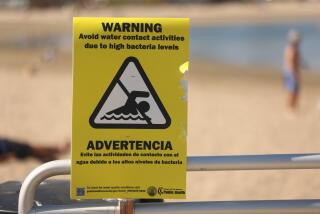Pollution Blamed in 2,400 Beach Closures : Oceans: Environmental group’s survey shows 402 shutdowns in California over two years.
- Share via
Contamination from sewage and storm water runoff resulted in 2,400 beach closures in 10 states, including at least 402 in California, during the past two years, a survey by the Natural Resources Defense Council revealed Wednesday.
The study, prompted by a tide of publicity over medical wastes and sewage that washed ashore on East Coast beaches in 1988, said “massive quantities” of raw or inadequately treated sewage continue to threaten the nation’s most popular seashores.
Beach-goers cannot be sure how safe it is to go into the water, the environmental group said, because health standards vary from state to state. Identical bacteria counts would close beaches--meaning the water was off limits to swimmers--in New Jersey but not in New York.
“There are discrepancies all over the place,” Veronica Kun, scientist for the Natural Resources Defense Council, said in Los Angeles. “Some places may be very diligent and some places are less diligent. But there’s no reason some places should be more protected than others. It’s an issue where national regulators should be taking a stand.”
Federal guidelines recommend that a beach be declared safe when only 19 out of 1,000 swimmers are likely to contract gastroenteritis, which can bring on fever, headache, nausea, stomachaches, vomiting and diarrhea. California’s standard allows a higher bacteria count but includes no risk estimates.
Yet there is no requirement by California that beaches be closed if bacteria counts exceed the state standard. That decision is left to individual counties. Of the 10 states, only New Jersey mandates beach closures when bacteria counts exceed the federal guidelines. “What this means is that when people go to the beach, they may find their beaches closed, or if open, they may run the risk of swimming in polluted waters,” said Sarah Chasis, a senior attorney for the council in New York.
In San Diego County, officials said things are even worse than the NRDC estimated. According to NRDC figures, county beaches were closed 50 times in 1989 and three times in 1990. But Gary Stephany, the county’s environmental health director, said that, so far this year, there have been 65 closures, and there were even more in previous years.
“I’d say their figures are way under,” Stephany said. But he said some beaches are not routinely tested unless they are near a sewer outfall. “Probably 80% to 90% of the time (swimmers in San Diego County) have nothing to worry about . . . (but) I think that’s a problem with our existing system.”
The environmental group said that 2.3 trillion gallons of effluent spill into U.S. waters annually from coastal sewage treatment plants.
Stephany was not the only official to question the NRDC report. Although conceding that beaches have posed public health problems, several health officials in the region said that, in criticizing state standards, the NRDC failed to point out that California counties often go farther to protect public health than federal guidelines suggest.
“We think as a public health agency we’re protecting the public health,” said Jack Petralia, environmental protection director for the Los Angeles County Health Services Department. “We try to the best we can with the information we have and always err on the side of safety.”
Petralia, as well as health officials in Orange and San Diego counties, said beaches are closed immediately after a sewage spill is discovered. The beaches are not reopened until laboratory tests confirm that the water is safe.
They also said beaches are closed when routine testing shows bacteria levels exceeding the state standard.
But the county officials acknowledged that beaches usually are not closed after a rain when storm water runoff drives the coliform bacteria count above state standards.
Coliform bacteria are found in soils as well as in human and animal waste but only coliform bacteria found in waste is of health concern. The coliform found in runoff is discounted because it contains the harmless soil bacteria.
“It’s the human sewage that causes the illness. Not all coliforms are human pathogens,” Orange County Environmental Health Director Fob Merryman said.
Officials, however, conceded that routine water sampling varies from county to county. For instance, Los Angeles County tests its beaches every week while San Diego County tests only four times during the summer.
“But there’s always the case we don’t know about,” said Gary Stephany, environmental health director for San Diego County. “You could be swimming in contaminated water for two or three days and not know about it.”
Stephany also cautioned that the state standard was developed 30 to 40 years ago without the benefit of current methods for determining risks to swimmers.
More to Read
Sign up for Essential California
The most important California stories and recommendations in your inbox every morning.
You may occasionally receive promotional content from the Los Angeles Times.










